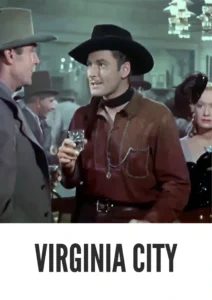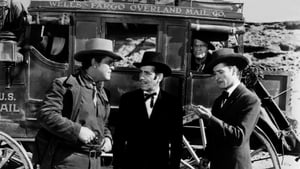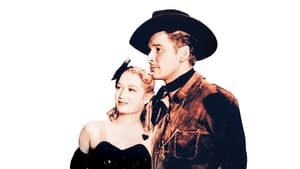Contact: info@alwanfilm.com
Video Sources 0 Views
- Watch trailer
- Virginia City


Synopsis
Table of Contents
ToggleReview: Virginia City 1940 Colorized – A Timeless Western Journey through the Wild West

Introduction
“In Virginia City 1940” stands as a testament to the enduring allure of the Western genre and the creative vision of its filmmakers. As we embark on this cinematic journey, we’ll delve into the significance of this early colored film and its impact on the world of cinema.
Check The Full Colorized Movies List
Check Our Colorized Movies Trailer Channel
Understanding Virginia City 1940 Colorized: Director, Cast, and Genre
Directed by the prolific Michael Curtiz, “In Virginia City 1940” showcases his mastery of storytelling and visual craftsmanship. The film boasts a star-studded cast, with Errol Flynn, Miriam Hopkins, and Humphrey Bogart delivering captivating performances that bring the Wild West to life on the silver screen. Set against the backdrop of the American Civil War, “In Virginia City 1940” seamlessly blends elements of action, romance, and drama, captivating audiences with its sweeping vistas and gripping narrative.
Exploring the World of Virginia City 1940 Colorized: Plot and Characters
At its core, “In Virginia City 1940” follows the exploits of a Union officer, portrayed by Errol Flynn, who embarks on a perilous mission to prevent Confederate forces from smuggling gold out of Virginia City. Along the way, he encounters a colorful array of characters, from a fiery Southern belle played by Miriam Hopkins to a ruthless Confederate sympathizer portrayed by Humphrey Bogart. As the stakes escalate and loyalties are tested, the stage is set for a showdown that will determine the fate of a nation.
The Art of Film Colorization
Film colorization has long been a contentious issue in the world of cinema, with purists arguing that it compromises the artistic integrity of classic films. However, when done tastefully and with respect for the original work, colorization can breathe new life into beloved movies, offering viewers a fresh perspective on familiar stories. In the case of “In Virginia City 1940,” the decision to release the film in a colorized format opens up new avenues for appreciation, allowing audiences to experience the beauty of the Wild West in vibrant hues.
Early Colored Films: A Brief History
The history of colored films dates back to the early days of cinema, with filmmakers experimenting with various techniques to add color to their creations. From hand-painted frames to early Technicolor processes, the evolution of colored film has been marked by innovation and ingenuity. As technology has advanced, so too has the art of colorization, with modern digital techniques offering filmmakers unprecedented control over the color palette of their films.
Virginia City 1940 and Its Early Colored Version
The decision to release “In Virginia City 1940” in a colorized format was met with both anticipation and apprehension. While some welcomed the opportunity to experience the film in vibrant color, others expressed concerns about the potential impact on its visual aesthetic. Nevertheless, the early colored version of “In Virginia City 1940” offers viewers a fresh perspective on the classic Western, enhancing its immersive qualities and bringing its richly detailed world to life in stunning detail.
The Debate Over Film Colorization
The debate over film colorization is a complex and multifaceted issue, with passionate arguments on both sides of the divide. Proponents argue that colorization revitalizes classic movies for modern audiences, breathing new life into timeless stories and introducing them to a new generation of viewers. Conversely, detractors maintain that colorization detracts from the authenticity of the original work, altering the director’s artistic intent and diminishing the historical significance of the film.
Examining Virginia City 1940 as an Early Colored Film
As with any colorized classic, the impact of colorization on “In Virginia City 1940” is a matter of personal interpretation. Some may argue that it enhances the film’s visual appeal and immerses viewers in its world, while others may feel that it detracts from the stark beauty of the original black and white version. Regardless of one’s stance on the issue, there’s no denying the enduring power of “In Virginia City 1940” as a cinematic masterpiece that continues to captivate audiences with its timeless themes and unforgettable characters.
Influence and Legacy: Virginia City 1940 Colorized’s Impact on Cinema
“In Virginia City 1940” has left an indelible mark on the world of cinema, inspiring countless filmmakers and spawning a Western remake trend that continues to this day. From Sergio Leone’s “A Fistful of Dollars” to a slew of Hollywood adaptations, the influence of “In Virginia City 1940” can be felt far and wide, cementing its status as a true classic of the genre. As audiences continue to rediscover this timeless treasure, its legacy will endure for generations to come.
Director’s Cinematic Legacy: Beyond Virginia City 1940 Colorized
Michael Curtiz’s influence extends far beyond “In Virginia City 1940,” with a vast body of work that continues to captivate audiences around the globe. From “Casablanca” to “The Adventures of Robin Hood,” Curtiz’s films are celebrated for their compelling narratives, dynamic characters, and timeless themes, solidifying his legacy as one of the greatest directors in cinematic history. Through his groundbreaking work, Curtiz has left an indelible imprint on the world of cinema, inspiring generations of filmmakers to follow in his footsteps.
Themes Explored in Virginia City 1940 Colorized
“In Virginia City 1940” explores a myriad of themes, from honor and loyalty to the pursuit of justice in a lawless land. Through its richly drawn characters and evocative imagery, the film invites viewers to ponder the complexities of morality and the human condition, offering insights into the enduring struggles of the human spirit. As audiences immerse themselves in the world of “In Virginia City 1940,” they are transported to a bygone era of adventure and excitement, where the line between right and wrong is often blurred and the true meaning of heroism is put to the test.
Reception and Controversy Surrounding Virginia City 1940 Colorized
Upon its release, “In Virginia City 1940” received widespread critical acclaim, with many praising its thrilling action sequences, stellar performances, and breathtaking cinematography. However, the decision to release the film in a colorized format sparked debate among fans and purists, reigniting the age-old discussion surrounding film preservation and artistic integrity. Despite the controversy, “In Virginia City 1940” remains a beloved classic that continues to resonate with audiences of all ages, reaffirming its status as a timeless masterpiece of the Western genre.
Where to Watch Virginia City 1940 Colorized Online
For those eager to experience the timeless magic of “In Virginia City 1940,” the film is readily available on popular streaming platforms such as Netflix, Amazon Prime, and Hulu. Whether you choose to watch it in its original black and white format or the early colored version, “In Virginia City 1940” promises to transport you to a world of adventure and excitement, where the spirit of the Wild West comes alive in vivid detail.
FAQs About Virginia City 1940
Q: Is “In Virginia City 1940” based on a true story? A: No, “In Virginia City 1940” is a fictional tale set against the backdrop of the American Civil War. While the film incorporates historical events and settings, its characters and plot are products of the screenwriter’s imagination rather than historical documentation.
Q: Who are the main actors in “In Virginia City 1940”? A: “In Virginia City 1940” features an ensemble cast of talented actors, led by the charismatic Errol Flynn in the role of a Union officer determined to thwart Confederate plans. Miriam Hopkins shines as the fiery Southern belle caught in the midst of the conflict, while Humphrey Bogart delivers a memorable performance as a cunning Confederate sympathizer. Supporting roles are filled by a host of skilled performers, each contributing to the film’s rich tapestry of characters and emotions.
Q: What awards did “In Virginia City 1940” win? A: While “In Virginia City 1940” did not win any major awards, its impact on the world of cinema cannot be overstated. The film garnered critical acclaim for its thrilling action sequences, stellar performances, and breathtaking cinematography, cementing its status as a beloved classic of the Western genre.
Q: Why was “In Virginia City 1940” released in a colorized format? A: The decision to release “In Virginia City 1940” in color was made to appeal to modern audiences and breathe new life into the film for a new generation of viewers. By presenting the story in vibrant hues, the filmmakers aimed to enhance the visual experience and capture the attention of audiences accustomed to modern cinematic techniques. While the choice to colorize the film sparked debate among purists, it ultimately introduced “In Virginia City 1940” to a wider audience and ensured its continued relevance in the annals of cinematic history.
Conclusion
As we reflect on the enduring legacy of “In Virginia City 1940,” let us celebrate its status as a timeless classic that continues to captivate audiences with its thrilling action, memorable characters, and breathtaking cinematography. Whether viewed in its original black and white format or the early colored version, “In Virginia City 1940” remains a shining example of the power of cinema to transport us to another time and place, inviting us to explore the depths of human experience and imagination.













